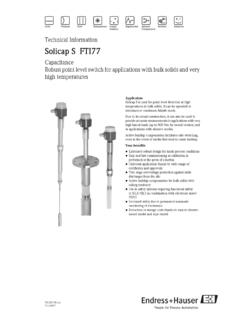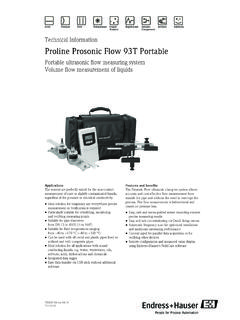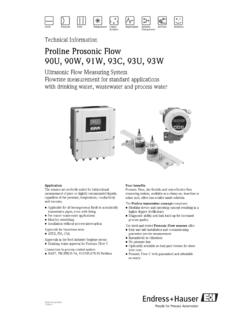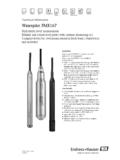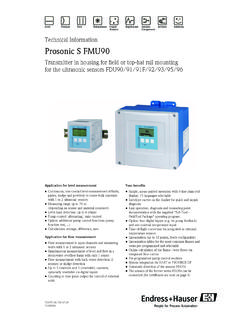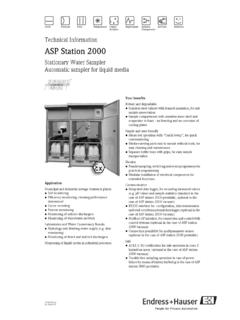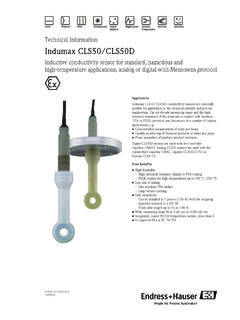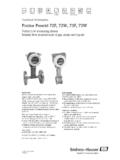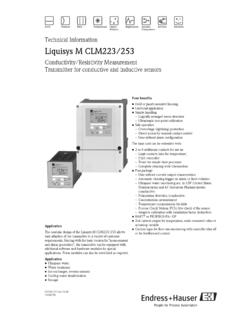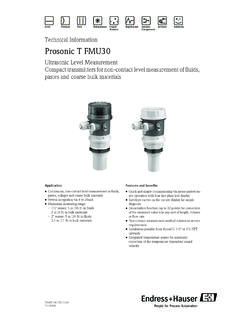Transcription of Technical Information Nivotester FTC325 - …
1 TI380F/00/ InformationNivotester FTC325 Level limit switchWith Intrinsically Safe Signal Circuit for Connectionto a Capacitance Sensor Applications Level limit detection in tanks containing liquids and silos containing bulk solids. For capacitance level probes, which may also be applied in hazardous areas of category ATEX II (1) GD Overspill protection for tanks containing flammable or non-flammable fluids hazardous to water Dry running protection for pumps Two-point control ( s with 3-WIRE)Your benefits Intrinsically safe signal circuit [EEx ia] IIC for using sensors in hazardous areas Calibration using operating keys High functional safety thanks to: fail-safe pulse-frequency modulation (PFM) or 3-WIRE technology Checkable relay function Compact housing for easy series mounting on a standard DIN rail in the cabinet Pluggable terminal blocks make wiring easy Can be used with FEI57S (PFM), EC16Z (PFM), EC17Z (PFM), FEI53 (3-WIRE) and EC61 (3-WIRE) Limit value and alarm relay WHG approval (PFM) Protection against maloperation and manipulation each change of the device configuration leads to signalling via the red LED and a fault message Nivotester FTC3252 Endress+HauserTable of contentsFunction and system design.
2 3 Measuring principle .. 3 Measuring device .. 5 Input parameters .. 8 Measured variable .. 8 Measuring range .. 8 Input signal .. 8 Output parameters.. 9 Output signal .. 9 Signal on alarm .. 9 Galvanic isolation .. 9 Overvoltage category as per EN 61010 .. 9 Protection class .. 9 Power supply .. 10 Electrical connection .. 10 Supply voltage .. 10 Power consumption .. 10 Operating conditions (installation conditions) .. 11 Installation instructions .. 11 Operating conditions (environmental conditions) .. 12 Installation location .. 12 Permitted ambient temperatures .. 12 Climatic and mechanical application class .. 12 Degree of protection .. 12 Electromagnetic compatibility (EMC).
3 12 Mechanical construction .. 13 Design, dimensions .. 13 Weight .. 14 Materials .. 14 Terminals .. 14 User interface .. 15 Display elements .. 15 Operating elements .. 15 Operating elements .. 16 Certificates and approvals .. 17 CEmark .. 17Ex approval .. 17 Type of protection .. 17 Overspill protection .. 17 Other standards and regulations .. 17 Ordering Information .. 18 Nivotester FTC325 PFM .. 18 Nivotester FTC325 3-WIRE .. 18 Accessories .. 19 Protective housing .. 19 Supplementary Documentation .. 19 System Information (SI) .. 19 Technical Information (TI) .. 19 Operating manual (KA) .. 19 Certificates (only for PFM) .. 19 Nivotester FTC325 Endress+Hauser3 Function and system designMeasuring principleFunctionProbe and tank (or ground tube/counterpotential) form a capacitor whose capacitance changes with the level of the product.
4 Signal transmissionThe signal input of the Nivotester FTC325 limit switch is galvanically isolated from the mains and from the output. Signal evaluationThe Nivotester analyses the frequency or the voltage signal, and switches the output relay for the level alarm. The switching state of the relay (energised or de-energised) is displayed on the front panel of the Nivotester by means of two yellow circuitSelecting the correct fail-safe circuit ensures that the relay always works in quiescent current fail-safe mode. Maximum fail-safe mode: the relay de-energises when the level rises above the switch point (sensor covered), a fault occurs or the power fails. Minimum fail-safe mode: the relay de-energises when the level falls below the switch point (sensor uncovered), a fault occurs or the power 3-WIREThe electronic insert FEI57, EC16Z or EC17Z converts the change of capacitance into a change of frequency, which switches the output relay in the Nivotester FTC325 electronic insert FEI53 or EC61 converts the change of capacitance into a voltage signal, which switches the output relay in the Nivotester FTC325 3-WIRE.
5 PFM3-WIREThe Nivotester supplies the capacitance sensor with intrinsically safe direct current via a two-wire cable and from there receives a frequency, which signals whether the level limit has been reached or , the transmitter superimposes current impulses (PFM signals) with a pulse width of approx. 200 s and a current intensity of approx. 10 mA on the supply current. The measuring capacitance lies in the range from 20 350pF. This corresponds to a transmission frequency of185 Nivotester supplies the capacitance sensor with direct current via a two-wire cable and receives the voltage signal via a third wire, which signals whether the level limit has been reached or not. The measuring capacitance lies in the range from 10 corresponds to a voltage of 3 FTC3254 Endress+HauserPFML00-FTC325xx-15-06-xx-e n-001 Function of the limit indicator dependent on the level and fail-safe circuit.
6 3-WIREL00-FTC325xx-15-06-xx-en-002 Function of the limit indicator dependent on the level and fail-safe circuit. 15 1615 1622 23 2422 23 2422 23 2422 23 2415 1615 16CH1CH1CH1CH1 NONONCNONCNONCNC15 1615 16 NONO15 1615 16 ProbeuncoveredProbecoveredLevelMaximumsa fety circuitMinimumsafety circuit456456CH1CH117 15 16456CH117 15 1617 15 16456CH117 15 16 ProbeuncoveredProbecoveredLevelMaximumsa fety circuitMinimumsafety circuitNivotester FTC325 Endress+Hauser5 Function monitoringTo increase operational safety the Nivotester is equipped with a function monitoring facility. A fault is displayed by the red light emitting diode and de-energises the relay for the level alarm and the alarm relay. A fault is reported if the Nivotester is no longer receiving a measuring signal.
7 This occurs, for example, when: there is a short-circuit the signal line to the sensor is interrupted the sensor electronics are defective the Nivotester 's input switching is defectiveAfter calibration, every further change to the device configuration de-energises the relay. A fault message is signalled via the red LED. Calibration key (red)Calibration is carried out automatically by means of operating keys. This makes setting via rotary switches test/correction key (green - FTC325 PFM only): allows for a function check of the output relay and alarm relay. confirms a change in the operating mode - by changing the switching delay after initial calibration. This enables a correction of the operating mode without requiring recalibration.
8 The changed settings are saved by pressing the operating switch functions An adjustable switching delay of s allows for the relay to be switched with a delay when covering or uncovering the probe. In the opposite direction, each switching delay is s. wo-point control ( s function, FTC325 3-WIRE), see page 7 A potentiometer (rotary switch) for shifting the operating point allows safe operation of the system, even with media that are prone to build-up. Measuring deviceA simple measuring system consists of a capacitance sensor, a Nivotester FTC325 and the control or signal instruments. The following sensors can be used in conjunction with the electronic inserts (EC) listed.* Phase-out: 2007, ** Phase-out: 2008, ** Phase-out: 2009 FTC325 PFMFTC325 3-WIREL iquicap M FTI51, FTI52 withFEI57 SFEI53 Solicap M FTI55, FTI56 withFEI57 SFEI53 Solicap S FTI77 withFEI57 SFEI53 Solicap FTC51*, FTC52*, FTC53* withEC17 ZEC61 Multicap T* withEC17 ZEC61 Multicap Classic* withEC16Z, EC17 ZEC61 Multicap EA* withEC17 ZHigh-temperature probes T12656**, T12892** withEC17 ZEC61 High-temperature probe 11500** withEC17 ZDouble rod probe 11304** with EC17 ZNivotester FTC3256 Endress+HauserProbe constructionLevel limit detection with FTC325 PFML00-FTC625xx-05-06-xx-en-000 Nivotester FTC325 PFMN ivotester FTC325 3-WIREThe measuring system consists of.
9 Sensor capacitance probe electronic insert FEI57S, EC16Z, EC17Z Nivotester FTC325 PFM Control or signal instrumentsThe measuring system consists of: Sensor one or two capacitance probes electronic insert FEI53, EC61 Nivotester FTC325 3-WIRE Control or signal instrumentsL00-FTC325xx-14-06-xx-xx-001 Partially or fully insulated probe <3 r<3>3>3>3 SludgeAqueous liquidsand alcoholsMoist bulk solidsDry bulk solidsSolvents, fuelslowConductivityBuild-upType of probe mountingfullinsulationpartialinsulationw ithground tubewithoutground tubeExample: Materiallowlowlowaverageaveragestronglow strongstrongvery strongUCH1 FTC325 TNivotester FTC325 Endress+Hauser7 Level limit detection with FTC325 3-WIREL00-FTC325xx-14-06-xx-xx-002 Partially or fully insulated probeL00-FTC325xx-14-06-xx-xx-004 Two-point control with fully insulated probeL00-FTC325xx-14-06-xx-en-001 Two-point control with two fully or partially insulated probes and an electronic insert EC61 resp.
10 FEI53. The probes are connected by a coaxial sUCH1CH13-WIREFTC32512EC6112 3 45 6 DsUFEI53 /EC6112 Coaxial cableNivotester FTC3258 Endress+HauserInput parametersMeasured variableThe limit signal is generated at minimum or maximum level, depending on the selectionMeasuring rangeThe measuring range is dependent on the mounting location of the signalFTC325 PFM FTC325 PFM input: galvanically isolated from power supply and output Type of protection: intrinsic safety [EEx ia] IIC Connectable sensors:Liquicap M (FTI51, FTI52) with FEI57 SSolicap M (FTI55, FTI56) with FEI57 SSolicap S (FTI77) with FEI57 SSolicap (FTC51, FTC52, FTC53)* with EC17 ZSMulticap T* with EC17 ZMulticap Classic* with EC16Z, EC17 ZMulticap EA* with EC17 ZHigh-temperature probes 11500**, T12656**, T12892** with EC17Z, EC27Z Double rod probe 11304** with EC17Z Sensor's power supply: from Nivotester FTC325 PFM Connecting cable: two-wire, shielded wire not required, except for strong electromagnetic interferences (see also Electromagnetic Compatibility (EMC) on page 12) Cable resistance: max.
